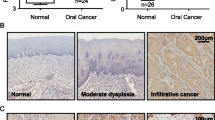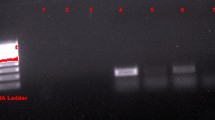Abstract
The present study investigated the expression of p8, a transcription factor upregulated in some human cancers, in oral squamous cell carcinomas (OSCCs). Immunohistochemical analysis of p8 expression was carried out on 20 archived surgical specimens of human OSCCs, and expression correlated with clinical outcome parameters in a retrospective study. Expression of p8 in a number of OSCC cell lines also was investigated by western blot and RT-PCR analyses. p8 was expressed in 80 % (16/20) of the samples with levels of expression exhibiting a significant difference (χ2 = 8.352, df = 3, p = 0.039) by patient age. Furthermore, greater levels of p8 immunoreactivity was significantly associated with advanced tumor grade (p = 0.008). p8 also was upregulated in OSCC cell lines. p8 is expressed in a significant proportion of OSCCs, and in human OSCC cell lines, suggesting a potential value of p8 as a diagnostic and/prognostic tool for oral cancers.




Similar content being viewed by others
References
Mallo GV, Fiedler F, Calvo EL, Ortiz EM, et al. Cloning and expression of the rat p8 cDNA, a new gene activated in pancreas during the acute phase of pancreatitis, pancreatic development, and regeneration, and which promotes cellular growth. J Biol Chem. 1997;272:32360–9.
Vasseur S, Mallo GV, Garcia-Montero A, et al. Structural and functional characterization of the mouse p8 gene: promotion of transcription by the CAAT-enhancer binding protein alpha (C/EBPalpha) and C/EBPbeta trans-acting factors involves a C/EBP cis-acting element and other regions of the promoter. Biochem J. 1999;343:377–83.
Ree AHM, Tvermyr O, Engebraaten M, et al. Expression of a novel factor in human breast cancer cells with metastatic potential. Cancer Res. 1999;59:4675–80.
Ree AH, Pacheco MM, Tvermyr M, Fodstad O, Brentani MM. Expression of a novel factor, com1, in early tumor progression of breast cancer. Clin Cancer Res. 2000;6:1778–83.
Pommier RM, Gout J, Vincent DF, et al. The human NUPR1/P8 gene is transcriptionally activated by transforming growth factor β via the SMAD signalling pathway. Biochem J. 2012;445:285–93.
Courjal F, Theillet C. Comparative genomic hybridization analysis of breast tumors with predetermined profiles of DNA amplification. Cancer Res. 1997;57:4368–77.
Gruel N, Lucchesi C, Raynal V, Rodrigues MJ, et al. Lobular invasive carcinoma of the breast is a molecular entity distinct from luminal invasive ductal carcinoma. Eur J Cancer. 2010;46:2399–407.
Mohammad HP, Seachrist DD, Quirk CC, Nilson JH. Reexpression of p8 contributes to tumorigenic properties of pituitary cells and appears in a subset of prolactinomas in transgenic mice that hypersecrete luteinizing hormone Mol. Endocrinol. 2004;18:2583–93.
Kong DK, Georgescu SP, Cano C, et al. Deficiency of the transcriptional regulator p8 results in increased autophagy and apoptosis, and causes impaired heart function. Mol Biol Cell. 2010;21:1335–49.
Gironella M, Malicet C, Cano C, et al. p8/nupr1 regulates DNA-repair activity after double-strand gamma irradiation-induced DNA damage. J Cell Physiol. 2000;221:594–602.
Sambasivan R, Cheedipudi S, Pasupuleti N, Saleh A, Pavlath GK, Dhawan J. The small chromatin-binding protein p8 coordinates the association of anti-proliferative and pro-myogenic sproteins at the myogenin promoter. J Cell Sci. 2009;122:3481–91.
Ogbureke KUE, Weinberger PM, Looney SW, Fisher LW. DSPP, OPN, and MMP-9 expression at histologically-negative resection margins predict Oral squamous cell carcinoma recurrence. Oncotarget. 2012;3:286–98.
Ogbureke KUE, Nikitakis NG, Warburton G, Ord R, Sauk JJ, Fisher LW. Upregulation of SIBLING proteins and correlation with cognate MMP expression in oral cancer. Oral Oncol. 2007;43:920–32.
Ogbureke KUE, Fisher LW. SIBLING expression patterns in ductal epithelia reflect the degree of metabolic activity. J Histochem Cytochem. 2007;55:403–9.
Hsu S, Yamamoto T, Borke J, et al. Green tea polyphenol-induced epidermal keratinocyte differentiation is associated with coordinated expression of p57/KIP2 and caspase 14. J Pharmacol Exp Ther. 2005;312:884–90.
Joshi R, Tawfik A, Edeh N, McCloud V, Looney S, Ogbureke KUE. Dentin sialophosphoprotein (DSPP) gene-silencing inhibits key tumorigenic activities in human oral cancer cell line, OSC2. PLoS ONE. 2010;5:e13974.
Gasparoni A, Fonzi L, Schneider GB, et al. Comparison of differentiation markers between normal and two squamous cell carcinoma cell lines in culture. Arch Oral Biol. 2004;49:653–64.
Chang SE, Foster S, Betts D, Marnock WE. DOK, a cell line established from human dysplastic oral mucosa, shows a partially transformed non-malignant phenotype. Int J Cancer. 1992;52:896–902.
Goruppi S, Bonventre JV, Kyriakis JM. Signaling pathways and late-onset gene induction associated with renal mesangial cell hypertrophy. EMBO J. 2002;21:5427–36.
Chowdhury UR, Samant RS, Fodstad O, Shevde LA. Emerging role of nuclear protein 1 (NUPR1) in cancer biology. Cancer Metastasis Rev. 2009;28:225–32.
Jiang WG, Davies G, Kynaston H, Mason MD, Fodstad O. Does the PGC-1/PPARgamma pathway play a role in Com-1/p8 mediated cell growth inhibition in prostate cancer? Int J Mol Med. 2006;18:1169–75.
Jiang WG, Davies G, Martin TA, et al. Com-1/p8 acts as a putative tumour suppressor in prostate cancer. Int J Mol Med. 2006;18:981–6.
Author information
Authors and Affiliations
Corresponding author
Electronic supplementary material
Below is the link to the electronic supplementary material.
Rights and permissions
About this article
Cite this article
Bingham, C., Dickinson, D., Cray, J. et al. Expression of p8 in Human Oral Squamous Cell Carcinoma. Head and Neck Pathol 9, 214–222 (2015). https://doi.org/10.1007/s12105-014-0565-1
Received:
Accepted:
Published:
Issue Date:
DOI: https://doi.org/10.1007/s12105-014-0565-1




